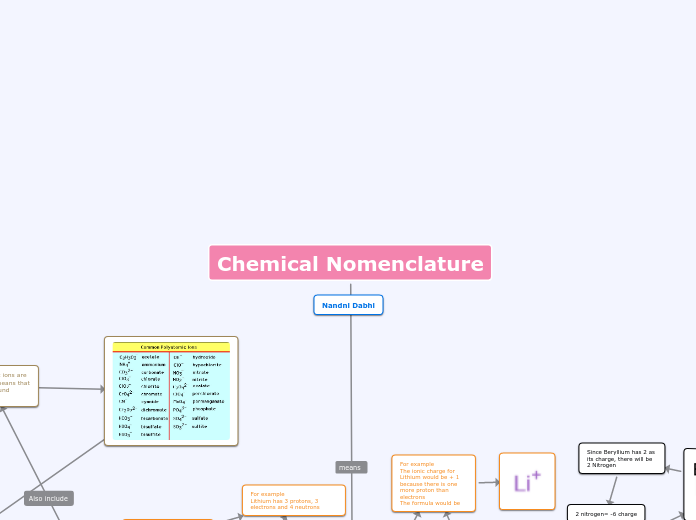da Nandni Dabhi mancano 5 anni
1112
Chemical Nomenclature

da Nandni Dabhi mancano 5 anni
1112

Più simili a questo
For example The ionic charge for Lithium would be + 1 because there is one more proton than electrons The formula would be
Since nitrogen has 3 as its charge, there will be 3 beryllium
3 beryllium= +6 charge
Since Beryllium has 2 as its charge, there will be 2 Nitrogen
2 nitrogen= -6 charge
Binary acids are molecular compounds that is combined with the element hydrogen.
For example
Chemical formula: NH4Cl
Cl also known as Chlorine is Metal atom with -1 charge
NH4 also known as Ammonium is a polyatomic ion because it is a chemical of Nitrogen and hydrogen which looks like this.
Since the amount of electrons is equal there is no need to add more atoms
These middle elements are called transition metals
Purple ones
Chemical formula: FeN3 Chemical Name: Iron(III) Nitrate
To make chemical formula both the atoms need to have the equal amounts of charges and in this case both the atoms have the same amount of charge
positive charge
a positively charged ion
negatively charged
"-ide"
Only non metal atoms always have the suffix ending of ide at the end of every chemical name. (the suffix only applies to the non metallic atoms)
a negatively charged ion
Molecular compounds
formed with 2 or more non metals
Diatomics
these are molecules of only 2 atoms that can only be seen together
These diatmoic elements are only seen alone when they are in a a compound with another atom
Iodine
Bromine
Chlorine
Fluorine
Oxygen
Hydrogen
short form to memorize the seven diatomic molecules
Lewis dot diagrams for covalent bonds
Lewis dot diagram is a diagram that shows the valence electrons of the atom
Valence electron are the electrons on the most outter shell of the bohr rutherford diagram
Lewis Dot Diagram for carbon
Bohr Rutherford Diagram for carbon
Carbon has 4 electrons on its most outer shell while makes carbon have 4 valance electrons
H2O
Step 1: Count the total number of valence electrons in the compound
Step 2: write the skeleton structure and place the element that needs the most electrons in the middle.
Step 3: Use two valence electrons to form each bond in the skeleton structure
Step 4: Add the remaining electrons to the center atom (make octets)
Now that 4 electrons are in its place, hydrogen has received all the electrons it needs, while oxygen still requires 4 more....so the four electrons would be placed on oxygen
Subtopic
Hydrogen only needs one electron while oxygen needs 2 so in that case oxygen would go in the middle
Covalent bonds
Is a attraction that holds together 2 atoms which (only non metals
Prefixs
covalent compounds naming always starts with prefix in front on the element name to indicate how many atoms the compound consists of.
Ex. PF3 P - Phosphorus - 1 (since its only 1 atom there would be no prefix in front) F - Fluorine - 3 (since it has 3 atom the prefix would be tri)
Phosphorus trifluoride
Special cases
NO2 + H2O HNO3
Simplifying equations
C6H12O6
CH6O
6
Harder compounds
Barium nitride
-3 electron charge
-6 electron charge with 2 nitrogen atoms
Barium
Both barium and nitrogen should have he same amount of charge in order for the elements to react with each other
2 electron charge
6 electron charge with 3 barium atoms
now both have equal amount of charges where the compound consists of 3 bariums and 2 nitrogen
Lewis dot diagram
Only represents the most outer shell electrons (valance electrons)
Sodium Nitride
Nitrogen
N
N^-3
There will be 3 sodium (Na) atoms
Na has one valence electrons so 3 sodium atoms would have a total of 3 valences electrons
This is called the skeleton structure which is the first part of the lewis dot diagram. N (Nitrogen) is in the middle because nitrogen needs the most electrons (needs 8 valence electrons but only has 5). Nitrogen can make a bridge all three sides to share electrons with sodium as sodium only needs 1 electron.
Now nitrogen shares 2 electrons with each sodium atom where sodium receives it 1 missing electrons and nitrogen receives 6 electrons in total, and the remaining 2 electrons go to nitrogen for its missing 2 electrons for the most outer shell
Lines also represent the electrons dot. 1 line = 2 electrons, 2 lines = 4 electrons, 3 lines = 6 electrons etc.
1x3=3
Sodium
Na
Na^1
There will be on nitrogen (N) atoms
N has five valence electrons so 1 nitrogen atoms would have a total of 5 valence electrons
5x1=5
Br3N2
Also known as a binary ionic
A mixture of two things
Ionic bonds
Is a attraction that would hold a positive and negative charged ions together in a compound. It's a transfer of electrons from a metal to a non metal.
Is a chemical bond or compound that is formed by two or more ions that are held together (metal ions and non-metal ions)
Naming compounds
How ionic compounds are formed
part 1